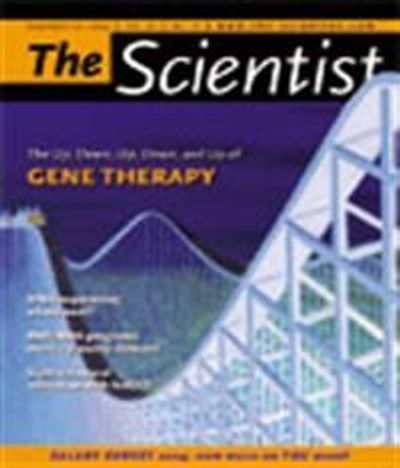© 2003 Nature Publishing Group
Above is a depiction of the genetic network engineered into

Synthetic biology is a new discipline based on the expectation of a revolution. In the future, bioengineers will create new organisms based on the same strategies that engineers use to design computer chips, bridges, and skyscrapers. Mathematical modeling will drive the design of useful, artificial organisms, instead of relying on the blind, trial-and-error methods of natural selection.
Advocates say synthetic biology will develop because of the rapidly decreasing cost of DNA synthesis and sequencing. Commercial plasmid-synthesis companies currently construct large pieces of DNA for less...
POLKA DOTS ON PLATES
In MIT's synthetic biology lab course,
Photo Courtesy of Pamela Silver

Once designed, instructors order the constructs deemed likely to work. Technicians and returning students are now looking to see if the artificial plasmid DNAs, when put into bacteria, can cause bacterial lawns to resolve into two states in a polka-dot pattern.
The biologist might respond that nature already makes all sorts of patterns to explore: zebra stripes, leopard spots, branching patterns in arteries and veins, and bilateral symmetry. For many years, biologists have developed mathematical models involving gradients, reaction-diffusion systems, and so on to explain these patterns. Others now work to rebuild them.
In one of the defining examples of synthetic biology, Michael Elowitz, California Institute of Technology, constructed an artificial biological oscillator consisting of a bacterium expressing three different repressors; repressor 1 turns off 2, repressor 2 turns off 3, and repressor 3 turns off 1.2 Biologists may say that nature does it better: The beating heart and the dividing cell are oscillatory patterns that are more regular, functional, and aesthetically pleasing than anything the synthetic biologists have designed. After years of study, biologists believe they understand how these oscillators work.
Revealing the engineer's soul that lurks within, the synthetic biologist will respond, "How do you know?" If we really understand how a biological entity works, and if we genuinely understand the design principles involved, then it should be possible to build an equivalent system. If we can't do this, says the engineer, our understanding is incomplete.
And for some synthetic biologists, the goal is not to understand biology per se, but to use it to build things. Small things. Important things.
BIOBRICKS AND MORTAR
At the first international synthetic biology meeting, held at Massachusetts Institute of Technology on June 10–12 and appropriately titled "Synthetic Biology 1.0," the University of California, Berkeley's Jay Keasling described the systematic engineering of
Many natural products with useful properties are based on terpene synthesis, such as the expensive cancer drug, Taxol. Keasling expects that his
The 'part' concept has been apotheosized in the term BioBrick, by the MIT Synthetic Biology Working Group
Synthetic biology proponents envision constructing reproducing calculators, plants that change color when they sense soil pollutants, and bacteria that can make just about anything. But these things are beyond our present capacity. One short-term goal is to create a microbe that can count to eight, for example, by synthesizing a fluorescent protein after eight cell divisions. In the medium term, the construction of a minimal organism, with just enough genes to grow, seems feasible.
Photo Courtesy of Pamela Silver

Such an organism could serve as a chassis into which additional synthetic DNA constructions could be added to obtain microbes that do interesting things, such as invade and destroy cancer cells. Since the smallest naturally occurring bacterial genome,
THE RIGHT TOOLS
By analogy to transistors, synthetic biologists are focused on creating the right tools, with the idea that the applications will materialize. Nature has already provided some useful suppplies. The zinc finger family of DNA-binding proteins contains well-defined modules that recognize specific DNA sequences. An individual 'finger' recognizes three bases in DNA, and there is a one-to-one relationship between each base and one of three particular amino acids in the finger. It is therefore possible to build individual fingers that recognize any possible DNA triplet. Plus, several zinc fingers can be strung together, with the resulting protein recognizing a series of triplets. Thus, synthetic zinc fingers could conceivably recognize any DNA segment of reasonable size.
In one of the most compelling examples of synthetic biology's potential, Homme Hellinga of Duke University has developed the systematic, computer-driven engineering of another protein family, the bacterial maltose receptor.4 Proteins in this family have two domains attached at a flexible hinge. On one face of the protein, a set of amino acids in both domains can bind a ligand such as maltose. When the ligand is bound, the protein locks into an open conformation, so that on the other side of the protein, a binding site for signal-transducing proteins becomes available and signaling results. Hellinga and his colleagues have modified the amino acids that recognize maltose, producing altered versions of the protein that can recognize a variety of small molecules, including serotonin and TNT.5
With cheap DNA synthesis, engineerable protein modules, additional DNA BioBricks, and enough computer modeling, it begins to appear reasonable that synthetic biologists will some day create living gizmos that we will use in our cars and houses, bacteria that parasitize cancer cells, or computers that use glucose as an energy source. This is the promise of synthetic biology.
Pamela Silver is professor of systems biology at Harvard Medical School and a member of The Dana Farber Cancer Institute, Boston. Her research interests include the systematic engineering of eukaryotic cells to address basic biological questions as well as the potential for drug discovery. She can be reached at
Jeffrey Way is director of intellectual property at EMD Lexigen Research Center, an affiliate of Merck KGaA, Darmstadt, Germany. The company is focused on highly engineered protein drugs. He can be contacted at
Interested in reading more?




